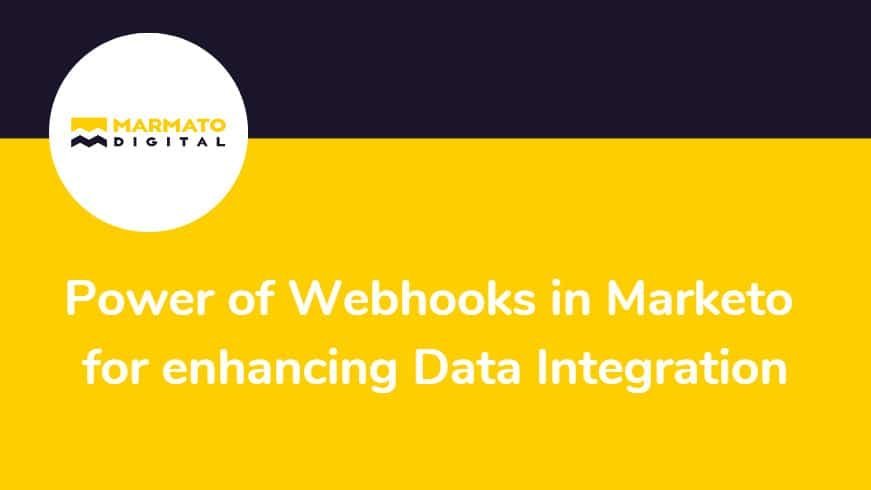In the world of Marketo, have you ever wondered how to enhance data integration and streamline processes? Well, the answer is webhooks. Let’s explore what is a webhook, how it works with Marketo, and how it can improve your data integration efforts.

What is a Webhook?
Webhooks serve as a bridge between different applications, allowing real-time communication and data exchange. In the context of Marketo, it enables seamless integration with external systems, such as CRM platforms or third-party analytics tools. This means that marketers can automate various processes, eliminating the need for manual data entry or repetitive tasks.
The power of webhooks lies in their ability to trigger actions based on specific events or conditions. For example, when a lead fills out a form on your website, a webhook can automatically send that information to your CRM system for further processing. Not only does this save time, but also ensures accurate and up-to-date data across all your marketing tools.
In summary, webhooks enable real-time communication between applications by automatically sending data when specific events occur. They simplify integration between systems and allow for efficient automation of tasks. Moreover, it eliminates the need for constant requests by pushing data directly to the specified URL when an event occurs. Eventually, this makes them highly efficient and reduces unnecessary network traffic.
How Marketo Webhooks work?
Imagine you’re running a webinar registration campaign through Marketo. When someone signs up for your webinar, you want to send them a personalized email confirmation immediately.
Without webhooks, this process might involve manual steps or scheduled tasks. However, with webhooks, the moment a user registers for your webinar, a trigger is sent automatically. Marketo doesn’t need to keep checking for new registrations; instead, it gets the notification instantly. The webhook collects data from the registration form and forwards it to Marketo, which then triggers the personalized email confirmation – all in a matter of seconds.
In simpler terms, webhooks eliminate the need for constant checking and waiting. They enable real-time communication between different applications, ensuring that actions happen as soon as they meet the predefined conditions.
Marketo Webhook Configuration:
Step 1: Understanding Webhooks
Before diving into Marketo-specific details, grasp the fundamental concept of webhooks. Essentially, it is a way for one system to provide real-time data to another system as soon as a specific event occurs. In Marketo, this means instantaneously updating lead information or triggering actions based on user interactions.
Step 2: Setting Up Webhooks in Marketo
- Access Marketo Webhook Configuration:
Log in to your Marketo account and navigate to the “Admin” section. From there, find the Webhooks option under Integration.
- Create a New Webhook:
Click on “New Webhook” or a similar option, depending on Marketo’s interface. Provide essential details such as the webhook URL (where to send the data), HTTP method (usually POST for webhooks), and authentication if required.
- Define Webhook Triggers:
Specify the events or actions that should trigger the webhook. For instance, you can set a trigger as a lead filling out a form or clicking a specific link.
Step 3: Configuring the Receiving End
- Prepare the Endpoint:
On the receiving end (where the webhook will send the data), ensure your server or application is ready to handle incoming requests. Create an endpoint URL capable of receiving and processing the data sent by Marketo.
- Data Mapping:
Understand the format in which Marketo sends data (often JSON or XML). Configure your receiving system to parse and process this data correctly.
Step 4: Testing the Webhook
- Test with Sample Data:
Before deploying your webhook in live campaigns, conduct a test with sample data. Moreover, this helps ensure that data is transmitted accurately and that your system processes it correctly.
- Check Responses:
Next, inspect the responses received from the webhook. Additionally, it’s important to note that Marketo often requires a specific response format to confirm successful delivery.
Step 5: Monitoring and Maintenance
- Monitoring Performance:
Once live, monitor the webhook’s performance regularly. In addition, check for any errors, delays, or issues in data transmission.
- Scaling and Optimization:
As your campaigns grow, consider optimizing your webhook setup. Further, this might involve enhancing error handling, adding additional triggers, or improving the data processing efficiency on the receiving end.
Enhancing Data Integration with Marketo Webhooks:
Webhooks enable seamless, real-time data integration, ensuring your Marketo platform is always in sync with the latest information. Moreover, this not only facilitates better decision-making but also empowers you to deliver highly personalized and effective marketing campaigns.
• Real-time Data Synchronization:
Webhooks are like the digital nerve center of your marketing operations. They allow you to connect Marketo with various data sources within and outside your organization. As data events occur in these sources, it instantly transmit this information to Marketo, ensuring your marketing database is continuously updated. Also, this real-time synchronization eliminates data lags, ensuring that you have the most current information at your fingertips.
• Accurate Customer Profiles:
One of the fundamental building blocks of successful marketing is knowing your audience inside out. Webhooks play a crucial role in keeping your customer profiles up-to-date. Whether it’s changes in contact details, lead scores, or engagement behavior, it ensures that every piece of information is reflected accurately in Marketo. This accuracy is the foundation for personalized marketing campaigns that resonate with your audience.
• Better Decision-Making:
In the fast-paced world of marketing, making data-driven decisions is non-negotiable. Webhooks provide a steady stream of real-time data to improve your strategies. For instance, if a lead visits your website and exhibits specific behaviors, it can trigger alerts or notifications in Marketo, prompting your team to take immediate action. Further, this agility enables you to make decisions swiftly and capitalize on opportunities as they arise.
• Personalized Marketing Campaigns:
Personalization is the heart of modern marketing, and webhooks are the arteries that deliver it. With real-time data integration, you can segment your audience based on their behavior, preferences, and interactions. When a lead takes a particular action, such as downloading an eBook or attending a webinar, it can trigger tailored follow-up emails, recommendations, or offers. Also, this level of personalization not only boosts engagement but also increases conversion rates.
• Reduced Manual Effort:
Most importantly, keeping your data up-to-date often involves manual tasks and batch processes. Nonetheless, this not only consumes a significant amount of time but also increases the likelihood of errors. Whereas webhooks automate the data integration process, freeing up your team to focus on strategic initiatives rather than data entry and maintenance.
• Scalability and Flexibility:
As your marketing efforts grow, webhooks can effortlessly scale with you. Whether you’re dealing with hundreds or thousands of leads and interactions, it can handle the data flow without breaking a sweat. Moreover, they are highly adaptable, allowing you to tailor data integration to your specific needs.
Conclusion:
In conclusion, understanding the potential of webhooks in Marketo is essential for modern-day marketers looking to streamline their marketing efforts and maximize efficiency. By automating processes and integrating various systems seamlessly, it enables personalized experiences at scale while providing valuable insights into campaign performance. Embracing this technology will undoubtedly propel your marketing strategies into the future.
Boost Your Marketing with Webhooks in Marketo!
Ready to harness the power of webhooks in Marketo but not sure where to start?
Marmato Digital is here to help you seamlessly set up and optimize your webhooks for maximum impact. We’ll work with you to ensure that it is configured correctly, securely, and efficiently so you can focus on what matters most: delivering exceptional marketing campaigns and engaging with your audience.
Contact us today to embark on your journey towards more efficient, data-driven marketing success with Marketo webhooks.
Subscribe to blogs
Get our latest blogs directly to your inbox.

